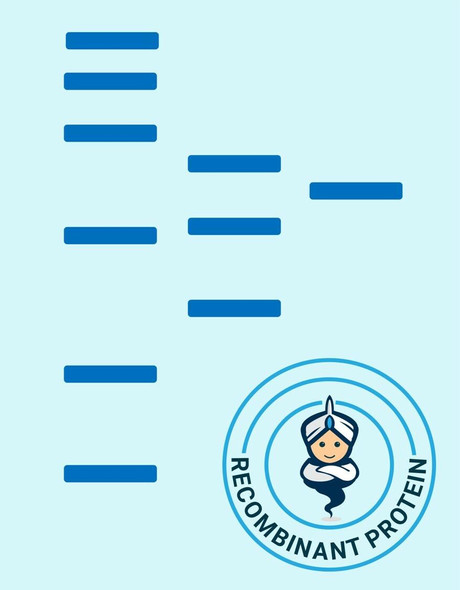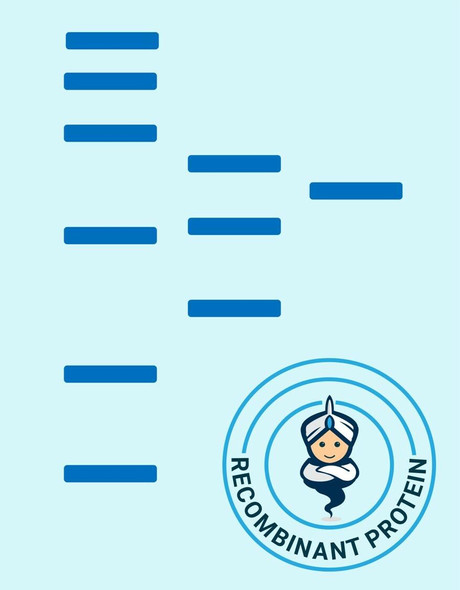Description
| Product Name: | Human CIB1 Recombinant Protein |
| Product Code: | RPPB2470 |
| Size: | 25µg |
| Species: | Human |
| Target: | CIB1 |
| Synonyms: | Calcium and integrin-binding protein 1, Calmyrin, DNA-PKcs-interacting protein, Kinase-interacting protein, SNK-interacting protein 2-28, SIP2-28, CIB1, CIB, KIP, PRKDCIP. |
| Source: | Escherichia Coli |
| Physical Appearance: | Sterile filtered colorless solution. |
| Formulation: | The CIB1 protein solution (1mg/ml) contains 20mM Tris-HCl, pH-8 & 5mM DTT. |
| Stability: | Store at 4°C if entire vial will be used within 2-4 weeks. Store, frozen at -20°C for longer periods of time.For long term storage it is recommended to add a 0.1% HSA or BSA. Avoid multiple freeze-thaw cycles. |
| Purity: | Greater than 95.0% as determined by SDS-PAGE. |
| Amino Acid Sequence: | MGSSHHHHHH SSGLVPRGSH MGGSGSRLSK ELLAEYQDLT FLTKQEILLA HRRFCELLPQ EQRTVESSLR AQVPFEQILS LPELKANPFK ERICRVFSTS PAKDSLSFED FLDLLSVFSD TATPDIKSHY AFRIFDFDDD GTLNREDLSR LVNCLTGEGE DTRLSASEMK QLIDNILEES DIDRDGTINL SEFQHVISRS PDFASSFKIV L |
CIB1 (Calcium and integrin binding 1) is regulatory protein with 50% homology to calmodulin and calcineurin B, that encodes a member of the calcium-binding protein family. CIB1 interacts with DNA-dependent protein kinase and may play a role in kinase-phosphatase regulation of DNA end joining.
CIB1 Human Recombinant is a single, non-glycosylated polypeptide chain (aa 1-191) containing a total of 211 amino acids and having a molecular mass of 23 kDa.CIB1 is fused to a 20 a.a His-tag and it was purified by conventional column chromatographic techniques.
| UniProt Protein Function: | CIB1: May convert the inactive conformation of integrin alpha- IIb/beta3 to an active form through binding to the integrin cytoplasmic domain. Induces cell migration and spreading mediated through integrin (possibly via focal adhesion complexes). Functions as a negative regulator of stress activated MAP kinase (MAPK) signaling pathways. May play a role in regulation of apoptosis. Interacts with and up-regulates PTK2/FAK1 activity. Down regulates inositol 1,4,5-trisphosphate receptor-dependent calcium signaling. Participates in endomitotic cell cycle, a form of mitosis in which both karyokinesis and cytokinesis are interrupted and is a hallmark of megakaryocyte differentiation. |
| UniProt Protein Details: | Protein type:Cell adhesion; Motility/polarity/chemotaxis Chromosomal Location of Human Ortholog: 15q25.3-q26 Cellular Component: Golgi apparatus; filopodium tip; centrosome; neuron projection; endoplasmic reticulum; nucleoplasm; growth cone; membrane; cell soma; perinuclear region of cytoplasm; lamellipodium; apical plasma membrane; cytoplasm; plasma membrane; nucleus; vesicle; sarcolemma Molecular Function:protein binding; Ras GTPase binding; protein anchor; calcium ion binding Biological Process: apoptosis; endomitotic cell cycle; negative regulation of megakaryocyte differentiation; cytoplasmic microtubule organization and biogenesis; activation of NF-kappaB transcription factor; negative regulation of cell proliferation; negative regulation of protein amino acid phosphorylation; double-strand break repair; positive regulation of cell proliferation; angiogenesis; positive regulation of cell-matrix adhesion; cell adhesion; negative regulation of protein kinase B signaling cascade; negative regulation of microtubule depolymerization; positive regulation of cell adhesion mediated by integrin; positive regulation of metalloenzyme activity; positive regulation of cell growth; regulation of cell proliferation; cell division; positive regulation of protein amino acid phosphorylation; platelet formation; response to DNA damage stimulus; regulation of cell division; spermatid development; negative regulation of apoptosis; positive regulation of cell migration |
| NCBI Summary: | This gene encodes a member of the EF-hand domain-containing calcium-binding superfamily. The encoded protein interacts with many other proteins, including the platelet integrin alpha-IIb-beta-3, DNA-dependent protein kinase, presenilin-2, focal adhesion kinase, p21 activated kinase, and protein kinase D. The encoded protein may be involved in cell survival and proliferation, and is associated with several disease states including cancer and Alzheimer's disease. Alternative splicing results in multiple transcript variants. [provided by RefSeq, Apr 2013] |
| UniProt Code: | Q99828 |
| NCBI GenInfo Identifier: | 134047806 |
| NCBI Gene ID: | 10519 |
| NCBI Accession: | Q99828.4 |
| UniProt Secondary Accession: | Q99828,O00693, O00735, Q6IB49, Q96J54, Q99971, B5BU40 H6WJF3, |
| UniProt Related Accession: | Q99828 |
| Molecular Weight: | 26,032 Da |
| NCBI Full Name: | Calcium and integrin-binding protein 1 |
| NCBI Synonym Full Names: | calcium and integrin binding 1 (calmyrin) |
| NCBI Official Symbol: | CIB1�� |
| NCBI Official Synonym Symbols: | CIB; CIBP; KIP1; PRKDCIP; SIP2-28�� |
| NCBI Protein Information: | calcium and integrin-binding protein 1; DNA-PK interaction protein; DNA-PKcs-interacting protein; SNK-interacting protein 2-28; DNA-dependent protein kinase interacting protein |
| UniProt Protein Name: | Calcium and integrin-binding protein 1 |
| UniProt Synonym Protein Names: | Calcium- and integrin-binding protein; CIBP; Calmyrin; DNA-PKcs-interacting protein; Kinase-interacting protein; KIP; SNK-interacting protein 2-28; SIP2-28 |
| Protein Family: | Calcium and integrin-binding protein |
| UniProt Gene Name: | CIB1�� |
| UniProt Entry Name: | CIB1_HUMAN |









